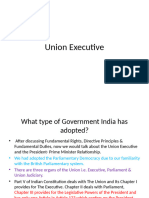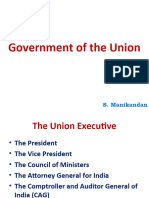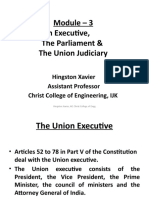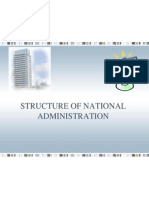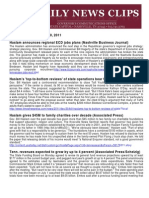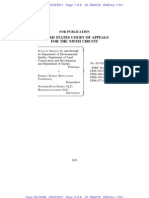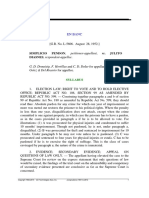0 ratings0% found this document useful (0 votes)
36 viewsUnion Government
Union Government
Uploaded by
fowminaThe Union Government of India consists of the President, Parliament, Prime Minister, and Council of Ministers. Parliament is made up of the Lok Sabha and Rajya Sabha. The Lok Sabha is the lower house whose members are directly elected for five-year terms. The Rajya Sabha has members elected for six-year terms. The Prime Minister is the head of the government and chooses the Council of Ministers. Collectively they form the Union Cabinet.
Copyright:
© All Rights Reserved
Available Formats
Download as PPTX, PDF, TXT or read online from Scribd
Union Government
Union Government
Uploaded by
fowmina0 ratings0% found this document useful (0 votes)
36 views32 pagesThe Union Government of India consists of the President, Parliament, Prime Minister, and Council of Ministers. Parliament is made up of the Lok Sabha and Rajya Sabha. The Lok Sabha is the lower house whose members are directly elected for five-year terms. The Rajya Sabha has members elected for six-year terms. The Prime Minister is the head of the government and chooses the Council of Ministers. Collectively they form the Union Cabinet.
Original Description:
UNION GOVERNMNET UNDER CONSTITUTION
Original Title
union government
Copyright
© © All Rights Reserved
Available Formats
PPTX, PDF, TXT or read online from Scribd
Share this document
Did you find this document useful?
Is this content inappropriate?
The Union Government of India consists of the President, Parliament, Prime Minister, and Council of Ministers. Parliament is made up of the Lok Sabha and Rajya Sabha. The Lok Sabha is the lower house whose members are directly elected for five-year terms. The Rajya Sabha has members elected for six-year terms. The Prime Minister is the head of the government and chooses the Council of Ministers. Collectively they form the Union Cabinet.
Copyright:
© All Rights Reserved
Available Formats
Download as PPTX, PDF, TXT or read online from Scribd
Download as pptx, pdf, or txt
0 ratings0% found this document useful (0 votes)
36 views32 pagesUnion Government
Union Government
Uploaded by
fowminaThe Union Government of India consists of the President, Parliament, Prime Minister, and Council of Ministers. Parliament is made up of the Lok Sabha and Rajya Sabha. The Lok Sabha is the lower house whose members are directly elected for five-year terms. The Rajya Sabha has members elected for six-year terms. The Prime Minister is the head of the government and chooses the Council of Ministers. Collectively they form the Union Cabinet.
Copyright:
© All Rights Reserved
Available Formats
Download as PPTX, PDF, TXT or read online from Scribd
Download as pptx, pdf, or txt
You are on page 1of 32
UNION GOVERNMENT
The Union of India
Union Legislature
• The Union Legislature is called the
Parliament.
• The Parliament of India consists of the
President of India
• . The two Houses are the Lok Sabha and
the
• Rajya Sabha.
Parliament
The sessions of the Parliament
Lok Sabha
• The Lok Sabha is the Lower House of the
• Parliament. The Members of the Lok
Sabha are directly
• elected by the citizens who are above
the age of 18. The
• maximum number of seats in the Lok
Sabha is 552.
Members of the Lok Sabha
• The Lok Sabha Members are elected for
a term of five years
• . A Member may contest election any
number of times.
• The Lok Sabha is dissolved on the expiry
of its full term of five years
Qualifications of Members of the
Lok Sabha
• (1) To becomea Member of the Lok
Sabha, one should be a citizen of
• (2) They must be at least 25 years
of age.
• (3) They should not have
been sentenced to
imprisonment.
• (4) Theyshould not be
Lok Sabha Speaker
• The powers and functions of the
Speaker are:
• deciding the matters to be discussed in
the House;
• maintaining the discipline and
dignity of the House;
• and conducting the discussion in
aproper manner, and taking decisions.
Rajya Sabha
Members of the Rajya Sabha
• To become a Member of the Rajya
Sabha,
• one must not be less than 30 years of
age.
• The term of the Rajya Sabha
Members is
six years. The
• The Vice-President of India is the
Chairman of the Rajya Sabha.
ROLE OF OPPOSTION
• pointing out the lapses, if any, on the
part of the Government;
• reviewing the policies and programmes
of the Government;
• and giving timely advice to the
Government, Cabinet and administrators.
The powers and functions of the
Parliament
• Legislative powers
• Financial powers
• Administrative powers
• Authority to amend the Constitution
The Union Executive
• The Union Executive is composed of the
President, PrimeMinister and his Council of
Ministers
The Union Executive
The Union Executive is composed of the
President, PrimeMinister and his Council
of Ministers
The elected
Members of both the
Houses of Parliament and
Members of
the Legislative
Assemblies of all States
elect the President
of India.
• The President is the head
President of the Indian
• Republic. He is called the
first citizen of the
country. His
• official residence is the
Rashtrapati Bhavan
•.
Qualifications of President
• 1. He should be a citizen of India.
• 2. He should have completed the age of
35 years.
• 3. He should be qualified for election
as a Member of the Lok Sabha.
• 4. He should not hold any office of profit
under the Government.
Rashtrapati Bhavan
Powres of the President
• Executive Powers
• Legislative Powers
• Judicial Powers
• Financial Powers
• Military Powers
• Emergency Powers
• Discretionary Powers
Vice-President
• The Members of both the Houses of
Parliament elect the Vice-President.
• The Vice-Presidentmust be over 35
years of age and have all the
qualificationsrequired to become
President.
• He is the Chairman of the Rajya
Sabha.
PRIME MINISTER
Importance of the Prime Minister
• The Prime Minister
• plays an important role in the
Parliamentary system of Government. His
responsibility is enormous in the matter
of national security.
powers and functions of the Prime
Minister
• 1 He is the Leader of the Lok Sabha.
• 2 He is the Head of the Government.
• 3 On the advice of the Prime Minister,
the Ministers are appointed by the
President.
• 4 He has the power to allot portfolios to
the Ministers.
• 5 He has the power to reshuffle the
Cabinet.
• 6 He recommends to the President the
removal of theMinisters.
Union Cabinet - Composition
• The President invites the
• Leader of the majority party elected by
the people to form the Government, and
appoints him as the Prime Minister.
• He appoints the remaining Ministers on
the advice ofthe Prime Minister.
• The Prime Minister and the Ministers
• form the Union Cabinet.
• The process of forming the Cabinet
• in this way is known as the Parliamentary
system or theCabinet system.
The Ministers are the political heads of
various departments.
Ministerial responsibility is the
essence
of the Cabinet system. Each Minister will be
personally responsible for the proper
functioning of his Department.
The Prime Minister allocates Departments to
the Ministers.
On certain occasion he can demand the
resignation of any Minister.
When the Prime Minister resigns, the Cabinet
will dissolve. When a majority of the
Members of Lok Sabha supports a No-
Confidence motion,the Cabinet resigns.
You might also like
- Assignment Form: Lejla Behra AE987GDocument2 pagesAssignment Form: Lejla Behra AE987GLejlaNo ratings yet
- Notice of Libel TORSTAR - July 11, 2018Document6 pagesNotice of Libel TORSTAR - July 11, 2018Diana DavisonNo ratings yet
- Unit 3Document47 pagesUnit 3xifoh46742No ratings yet
- Union LegislatureDocument41 pagesUnion LegislatureTribhuwan PantNo ratings yet
- Module 4 - DbitbangalorepdfDocument45 pagesModule 4 - Dbitbangalorepdfsinan2004mdNo ratings yet
- Union Executive of Indian Constitution Upsc Notes 67Document3 pagesUnion Executive of Indian Constitution Upsc Notes 67Sahil KambojNo ratings yet
- Class Vii Civics Chapter 3 PptDocument9 pagesClass Vii Civics Chapter 3 PptMINA MANCHANDANo ratings yet
- Parliament and PresidentDocument15 pagesParliament and Presidentrushilmishra7No ratings yet
- President of IndiaDocument19 pagesPresident of IndiaAbhishek RathodNo ratings yet
- Important Points Class: X Sub: History & Civics Ls. 1 The Union ParliamentDocument4 pagesImportant Points Class: X Sub: History & Civics Ls. 1 The Union ParliamentAvangapuram JyothiNo ratings yet
- CH 3 Why Do we-WPS OfficeDocument2 pagesCH 3 Why Do we-WPS OfficeHitesh BiswasNo ratings yet
- Superfast Revision Civics 2023Document44 pagesSuperfast Revision Civics 2023jcxfpd8k6fNo ratings yet
- Entire Civics 2024Document49 pagesEntire Civics 2024jcxfpd8k6fNo ratings yet
- L13 - Union - Executive, - President-Prime - Minister - RelationshipDocument17 pagesL13 - Union - Executive, - President-Prime - Minister - Relationshipshafinsq15No ratings yet
- Pols203 Week 4 - 146512Document12 pagesPols203 Week 4 - 146512shaykh.faNo ratings yet
- Union Exective and State ExecutiveDocument32 pagesUnion Exective and State ExecutiveAyan SiddiquiNo ratings yet
- Coi Module 4 PPT 1Document13 pagesCoi Module 4 PPT 1rain MCNo ratings yet
- Civics Chapter 1 - The Union LegislatureDocument35 pagesCivics Chapter 1 - The Union LegislatureThangsian KhaiNo ratings yet
- Module-3 Central Government 2Document35 pagesModule-3 Central Government 2shubh suriNo ratings yet
- Government of The UnionDocument99 pagesGovernment of The UnionRuhitha Shanmugham VenkateswariNo ratings yet
- Chapter 3 Why Do We Need A Parliament WatermarkDocument15 pagesChapter 3 Why Do We Need A Parliament WatermarkKrypton HalideNo ratings yet
- Module 3 Indian ConstitutionDocument9 pagesModule 3 Indian Constitutionajmalajupyk2424No ratings yet
- Union GovernmentDocument7 pagesUnion Governmentprashantha2341No ratings yet
- COI MODULE 3 PPT 2 KtuDocument9 pagesCOI MODULE 3 PPT 2 Kturain MCNo ratings yet
- Parliamentary Democracy-Chapter 5Document33 pagesParliamentary Democracy-Chapter 5MuhdJameelNo ratings yet
- Vice President, Prime Minister & Council of Minis - 21630068Document25 pagesVice President, Prime Minister & Council of Minis - 21630068karthikarjunan48No ratings yet
- President 21630070Document15 pagesPresident 21630070karthikarjunan48No ratings yet
- COI - Module - 3Document33 pagesCOI - Module - 3S A N J A N A BLOOMBERRYPEACH100% (1)
- POWERS AND FUNCTIONS OF PRIME MINISTER OF INDIA (1)Document16 pagesPOWERS AND FUNCTIONS OF PRIME MINISTER OF INDIA (1)saranandmeNo ratings yet
- Indian Govt NotesDocument6 pagesIndian Govt NotesparshvasanghviiNo ratings yet
- Mod 5 IcDocument53 pagesMod 5 Icsinan2004mdNo ratings yet
- Parliamentary and Presidential GovernmentDocument16 pagesParliamentary and Presidential GovernmentNISHCHAY SINGHNo ratings yet
- The Prime Minister of IndiaDocument4 pagesThe Prime Minister of Indiab200501038No ratings yet
- Study Material - Topic - Legislature and Judiciary - 26-01-2024 - Dr. Sumit K PanjaDocument12 pagesStudy Material - Topic - Legislature and Judiciary - 26-01-2024 - Dr. Sumit K PanjaatushdankharaNo ratings yet
- Why Do We Need A ParliamentDocument13 pagesWhy Do We Need A ParliamentKANAV BINDRANo ratings yet
- Xero or Hundred BookDocument12 pagesXero or Hundred BookRajveer NaharNo ratings yet
- State ExecutiveDocument31 pagesState ExecutiveTribhuwan Pant0% (1)
- France China and IndiaDocument45 pagesFrance China and IndiaSamina TariqNo ratings yet
- Grade 8 - Civics - Unit 15 QADocument6 pagesGrade 8 - Civics - Unit 15 QAemlynjiteshtNo ratings yet
- La Martiniere Girls' College: Class Viii AssignmentDocument12 pagesLa Martiniere Girls' College: Class Viii AssignmentPalakNo ratings yet
- 078) L3 - President, VP, PM, and COMDocument94 pages078) L3 - President, VP, PM, and COMRahul PanwarNo ratings yet
- Executive (Chapter Summary)Document7 pagesExecutive (Chapter Summary)harshnishad809No ratings yet
- Chapter-5 Political Science Working of Institutions: Major Policy DecisionDocument2 pagesChapter-5 Political Science Working of Institutions: Major Policy DecisionVedang GuptaNo ratings yet
- Working of InstitutionsDocument36 pagesWorking of Institutionsstabgaming.19No ratings yet
- ParliamentDocument13 pagesParliamentjass preetNo ratings yet
- COI - Module - 3 - KQB KtuQbankDocument30 pagesCOI - Module - 3 - KQB KtuQbankfodab57232No ratings yet
- Resource 20231109155959 Chapter - 5 Working of InstitutionsDocument17 pagesResource 20231109155959 Chapter - 5 Working of Institutionshsnarula37No ratings yet
- CS Module 2Document45 pagesCS Module 2btech25065.21No ratings yet
- State Government-Running Notes 2023-24Document3 pagesState Government-Running Notes 2023-24Marwa SuhailNo ratings yet
- State LegislatureDocument27 pagesState LegislatureSuryagayathri SNo ratings yet
- Parliament 21630069Document17 pagesParliament 21630069karthikarjunan48No ratings yet
- Parliament-Testbook NotesDocument10 pagesParliament-Testbook Notesrajhp54321No ratings yet
- Unit 5 Organs of Constitutional Governance Legislature, ExecutiveDocument9 pagesUnit 5 Organs of Constitutional Governance Legislature, ExecutiveKhushi SinghNo ratings yet
- Polity Governor, CM and State Legislature NotesDocument7 pagesPolity Governor, CM and State Legislature NotesetherealscrutiniseNo ratings yet
- IC- Unit 2Document14 pagesIC- Unit 2Kavya ANo ratings yet
- Indian Constitution Module Iii NotesDocument9 pagesIndian Constitution Module Iii Notesabinayasree2412No ratings yet
- Indian ParlimentDocument7 pagesIndian Parlimentsrinika521No ratings yet
- Diksha Material No.315e70eadcf3ea46.40995719Document64 pagesDiksha Material No.315e70eadcf3ea46.40995719debabratabarman220No ratings yet
- India Executive Branch IIDocument37 pagesIndia Executive Branch IINaiza Mae R. BinayaoNo ratings yet
- Screenshot 2022-02-15 at 8.00.01 PMDocument4 pagesScreenshot 2022-02-15 at 8.00.01 PMriteshpanjwani4No ratings yet
- Structure of National AdministrationDocument17 pagesStructure of National AdministrationFernando JahanamNo ratings yet
- Ra 7722Document5 pagesRa 7722Niel A.No ratings yet
- Consti G1 G12Document523 pagesConsti G1 G12River Mia RomeroNo ratings yet
- Indian Administration - Organisation and Functions Central Administration - Organisation and FunctionsDocument15 pagesIndian Administration - Organisation and Functions Central Administration - Organisation and FunctionsgrsrikNo ratings yet
- Whatnext Edutech LLP: Salary Slip For February - 2020Document1 pageWhatnext Edutech LLP: Salary Slip For February - 2020NAVEEN ROYNo ratings yet
- CDR SC JaidwalDocument68 pagesCDR SC JaidwalbabbuNo ratings yet
- Rule of Law Legal Methods PDFDocument11 pagesRule of Law Legal Methods PDFManishaNo ratings yet
- 88 Dayrit Vs CADocument5 pages88 Dayrit Vs CARap PatajoNo ratings yet
- Ripple Opposition To SEC's Request To Extend Discovery DeadlineDocument14 pagesRipple Opposition To SEC's Request To Extend Discovery DeadlineJubyNo ratings yet
- TORTS AND DAMAGES ReviewerDocument13 pagesTORTS AND DAMAGES ReviewerJoannah Gamboa100% (4)
- Estrada OaniDocument26 pagesEstrada OaniAerith AlejandreNo ratings yet
- Compliance Monitoring Report (CMR)Document15 pagesCompliance Monitoring Report (CMR)Patrick GoNo ratings yet
- G.R. No. 139587Document9 pagesG.R. No. 139587Kael de la CruzNo ratings yet
- Tues., Dec. 20 News SummaryDocument12 pagesTues., Dec. 20 News SummaryTNSenateDemsNo ratings yet
- Bid FormDocument2 pagesBid FormDianara De GuzmanNo ratings yet
- EHS Service Contract Agreement 2013Document133 pagesEHS Service Contract Agreement 2013Ravic KumarNo ratings yet
- Employee HandbookDocument14 pagesEmployee Handbookapi-251541061No ratings yet
- David v. Agbay GR No. 199113, Mar. 18, 2015Document3 pagesDavid v. Agbay GR No. 199113, Mar. 18, 2015Nikki Diane CadizNo ratings yet
- United States Court of Appeals For The Ninth CircuitDocument8 pagesUnited States Court of Appeals For The Ninth CircuitcprofitaNo ratings yet
- Investment Analysis and Portfolio ManagementDocument5 pagesInvestment Analysis and Portfolio Managementpanoop12No ratings yet
- Claw Assignment NewestDocument6 pagesClaw Assignment NewestclaraNo ratings yet
- Circular Panama 336Document4 pagesCircular Panama 336luisverde64No ratings yet
- Justice Teresita Leonardo-De Castro Cases (2008-2015) : Criminal LawDocument27 pagesJustice Teresita Leonardo-De Castro Cases (2008-2015) : Criminal LawLynn PalisNo ratings yet
- (G.R. No. 190389, April 19, 2017) : Leonen, J.Document14 pages(G.R. No. 190389, April 19, 2017) : Leonen, J.Farahleen Pearl PalacNo ratings yet
- Adobe Scan 19-Jul-2023Document18 pagesAdobe Scan 19-Jul-2023g SACHIVALAYAMNo ratings yet
- Project 25 Commitment FormDocument1 pageProject 25 Commitment Formdee karlNo ratings yet
- Preventive Machinery of Industrial DisputesDocument13 pagesPreventive Machinery of Industrial DisputestiaramuhammedNo ratings yet
- Dominion Insurance v. CA, GR. No. 129919, 6 February 2002Document8 pagesDominion Insurance v. CA, GR. No. 129919, 6 February 2002Krista YntigNo ratings yet
- Pendon v. Diasnes PDFDocument5 pagesPendon v. Diasnes PDFmonagbayaniNo ratings yet













